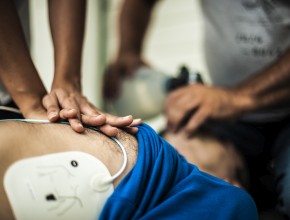Hyperoxia and hypertonic saline in patients with septic shock
Girardis M, Busani S, Damiani E, et al. Effect of Conservative vs Conventional Oxygen Therapy on Mortality Among Patients in an Intensive Care Unit: The Oxygen-ICU Randomized Clinical Trial. JAMA. 2016 Oct 18;316(15):1583-1589. doi: 10.1001/jama.2016.11993. PubMed PMID: 27706466. (As summarized in Highlights for Monday, October 24, 2017.)
Using very high levels of oxygen in patients with septic shock may be harmful.
For the first 24 hours after enrollment in the study, over 400 patients with the diagnosis of septic shock on mechanical ventilation received either 100% oxygen (hyperoxia group) or a concentration of oxygen providing an arterial hemoglobin oxygen saturation of 88% to 95% (normoxia group). The study was stopped earlier than planned for safety reasons: 28-day mortality was 43% in patients with hyperoxia versus 35% in the normoxia group (hazard ratio [HR], 1.27; 95% confidence interval [CI], 0.94-1.72).
In a separate part of the study, the authors compared bolus fluid resuscitation during the first 72 hours using either 0.9% sodium chloride (normal saline) or 3% sodium chloride. The observations included mortality rates numerically higher in the 3% sodium chloride group (42% vs 37%; HR, 1.19; 95% CI, 0.88-1.61), a large number of patients developing hypernatremia in that group, and a similar cumulative fluid use over the first 72 hours in the hypertonic and isotonic groups.
In conclusion, even short-term hyperoxia may be harmful in this population. Such findings complement previous reports (see Highlights for Monday, October 24). The use of hypertonic saline for bolus resuscitation had no benefits.
Position statement: optimal care of the postarrest patient. Part 1
Survival among people with out-of-hospital cardiac arrest (OHCA) is very low. These Canadian guidelines provide some directions for the management of such patients.
Strong recommendations include targeted temperature management (TTM) for unresponsive patients with an initial shockable rhythm after return of spontaneous circulation and a target temperature from 33°C to 36°C. Weaker recommendations (suggestions) include the use of the initially chosen TTM threshold for at least 24 hours; the use of TTM in OHCA patients with an initial nonshockable rhythm; the use of TTM in in-hospital patients with cardiac arrest; the use of either surface cooling or intravascular cooling techniques; and the use of cooling beyond 24 hours to prevent an elevation of temperature above 37.5°C.
In a separate section, the authors recommend, when feasible, (1) immediate coronary angiography in OHCA patients with ST-segment elevation myocardial infarction (STEMI); or (2) fibrinolytic therapy if not contraindicated and timely angiography and primary percutaneous coronary intervention cannot be performed. They also recommend that troponin measurements not be used to predict the presence of coronary lesions. The authors suggest performing angiography among patients without STEMI if there is a suspicion of ischemic etiology and suggest that TTM and angiography could be performed in parallel if both are indicated. For the prevention of shivering associated with TTM, suggestions include a stepwise approach with acetaminophen (INN paracetamol), intravenous magnesium, or skin counterwarming followed by opioids, propofol, or dexmedetomidine before using neuromuscular blockade.
Pregabalin for acute and chronic sciatica
Attal N, Barrot M. Is Pregabalin Ineffective in Acute or Chronic Sciatica? N Engl J Med. 2017 Mar 23;376(12):1169-1170. doi: 10.1056/NEJMe1701147. PubMed PMID: 28328344.
Pregabalin, a medication used to treat some types of neuropathic pain, was not effective in an 8-week treatment of sciatica.
The study examined the effects of an 8-week use of pregabalin, in a dose of 150 mg per day increasing gradually to 600 mg per day, as compared to placebo in patients with sciatica. Sciatica was defined as pain radiating into one leg below the knee accompanied by at least one of dermatomal leg pain, myotomal weakness, sensory deficits, or diminished reflex; the pain was to be of at least moderate intensity, present from a minimum of 1 week to a maximum of 1 year, and result in at least moderate limitation of activities. Over the course of the study, there was a significant improvement in symptoms in both groups, but no obvious statistical or clinical differences between treatments except adverse events (mostly dizziness) in the pregabalin group.
In the accompanying editorial, the authors point out that most patients had pain characteristics different from those of neuropathic pain, and that many of them had pain for less than 3 months, which suggests that the possibility of detecting beneficial effects of pregabalin in chronic pain and in pure neuropathic pain was decreased.
 English
English
 Español
Español
 українська
українська





